ESP GMC JIMMY 1997 Owner's Manual
[x] Cancel search | Manufacturer: GMC, Model Year: 1997, Model line: JIMMY, Model: GMC JIMMY 1997Pages: 410, PDF Size: 20.03 MB
Page 23 of 410
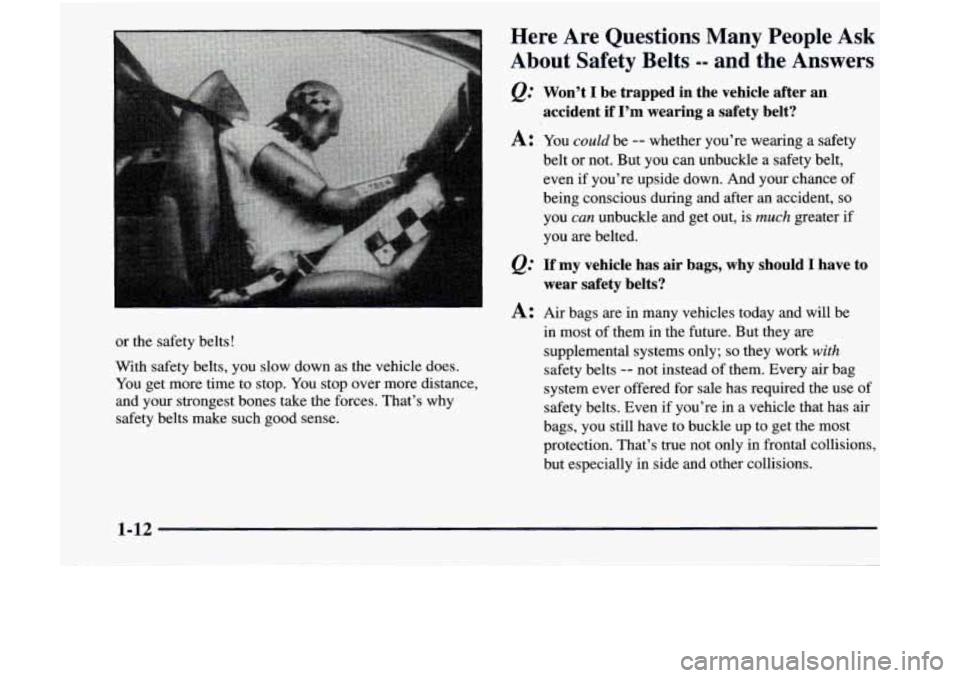
or the safety belts!
With safety belts, you slow down as the vehicle does.
You get more time to stop. You stop over more distance,
and your strongest bones take the forces. That’s why
safety belts make such good sense.
Here Are Questions Many People Ask
About Safety Belts
-- and the Answers
&: Won’t I be trapped in the vehicle after an
accident if I’m wearing a safety belt?
A: You could be -- whether you’re wearing a safety
belt or not. But you can unbuckle a safety belt,
even if you’re upside down. And your chance of
being conscious during and after an accident,
so
you can unbuckle and get out, is much greater if
you are belted.
@’ If my vehicle has air bags, why should I have to
wear safety belts?
A: Air bags are in many vehicles today and will be
in most of them in the future. But they are
supplemental systems only;
so they work with
safety belts -- not instead of them. Every air bag
system ever offered for sale has required the use of
safety belts. Even if you’re in a vehicle that has
air
bags, you still have to buckle up to get the most
protection. That’s true not only
in frontal collisions,
but especially in side and other collisions.
1-12
I
Page 34 of 410
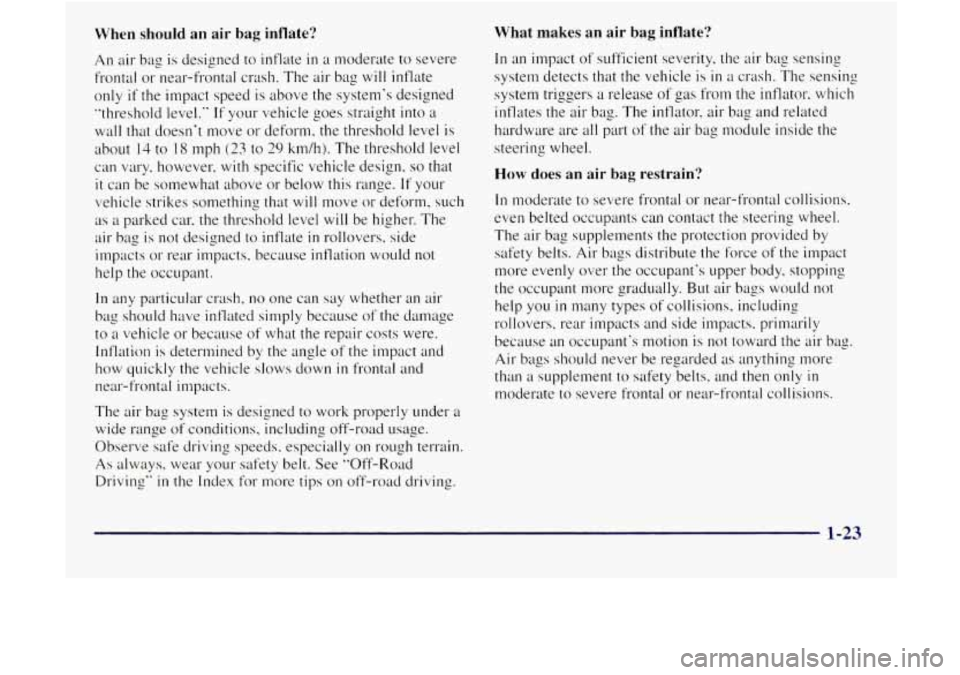
When should an air bag inflate?
An air bag is designed to inflate in a moderate to severe
frontal or near-frontal crash. The air bag will inflate
only
if the impact speed is above the system's designed
"threshold level."
If your vehicle goes straight into a
wall that doesn't move or deform. the threshold level is
about
14 to 18 mph (23 to 29 km/h). The threshold level
can vary, however,
with specific vehicle design. so that
it can be somewhat above or below this range. If your
vehicle strikes something
that will move or deform, such
as a parked car. the threshold level will be higher. The
air
bag is not designed to inflate in rollovers, side
impacts or rear impacts. because inflation would not
help the occupant.
In any particular crash, no one can say whether an air
bag should have inflated simply because of the damage
to a vehicle or because of what the repair costs were.
Inflation is determined
by the angle of the impact and
how quickly the vehicle slows down in frontal and
near-frontal impacts.
The air bag system
is designed to work properly under a
wide range of conditions, including off-road usage.
Observe safe driving speeds. especially
on rough terrain.
As always. wear your safety belt. See "Off-Road
Driving"
in the Index for Inore tips on off-road driving.
What makes an air bag inflate?
In an impact of sufficient severity, the air bag sensing
system detects that the vehicle is
in a crash. The sensing
system triggers a release of gas from
the inflator. which
inflates
the air bag. The inflator, air bag and related
hardware
are all part of the air bag module inside the
steering wheel.
How does an air bag restrain?
In tnoderate to severe frontal or near-frontal collisions.
even belted occupants can contact the steering wheel.
The air bag supplements the protection provided by
safety belts. Air bags distribute the force
of the impact
more evenly over
the occupant's upper body. stopping
the occupant more gradually.
But air bags would not
help you in many types of collisions, including
rollovers. rear impacts and side impacts. primarily
because an occupant's motion is
not toward the air bag.
Air bags should never be regarded as anything more
than a supplement
to safety belts. and then only in
moderate to severe frontal or near-frontal collisions.
1-23
Page 65 of 410
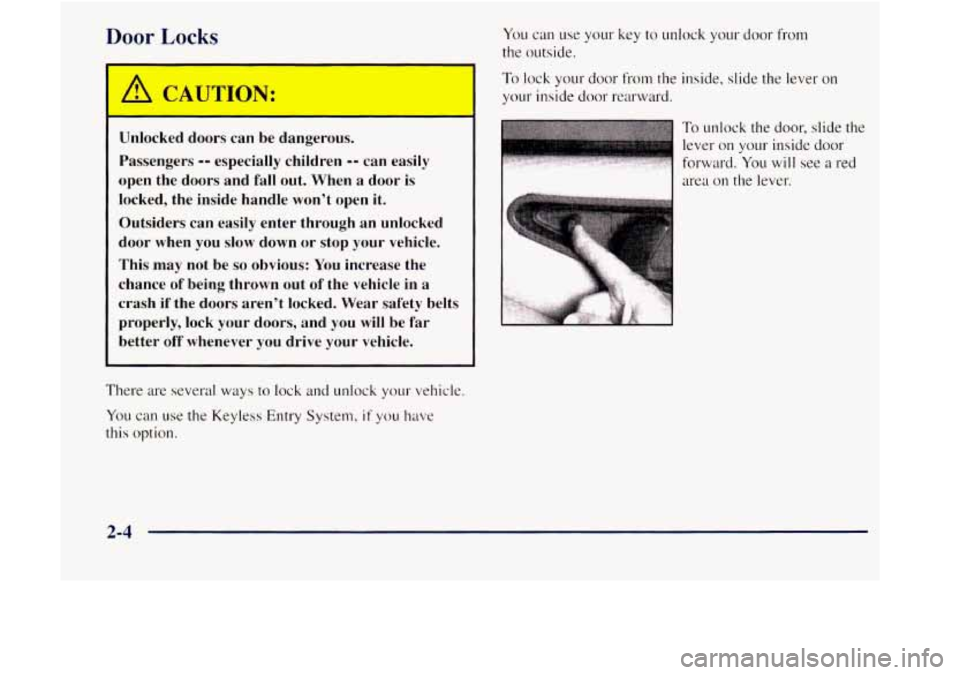
Door Locks
Unlocked doors can be dangerous.
Passengers
-- especially children -- can easily
open the doors and
fall out. When a door is
locked, the inside handle won’t open it.
Outsiders can easily enter through
an unlocked
door when you slow down or stop your vehicle.
This may not be
so obvious: You increase the
chance of being thrown out of the vehicle in a
crash if the doors aren’t locked. Wear safety belts
properly, lock your doors, and you will be far
better off whenever you drive your vehicle.
There are several ways
to lock and unlock your vehicle.
You can use the Keyless Entry System, if YOLI have
this option.
To lock your door from the inside, slide the lever on
your inside door rearward.
To unlock the door, slide the
lever on your inside
door
forward. You will see a red
area
on the lever.
2-4
Page 69 of 410
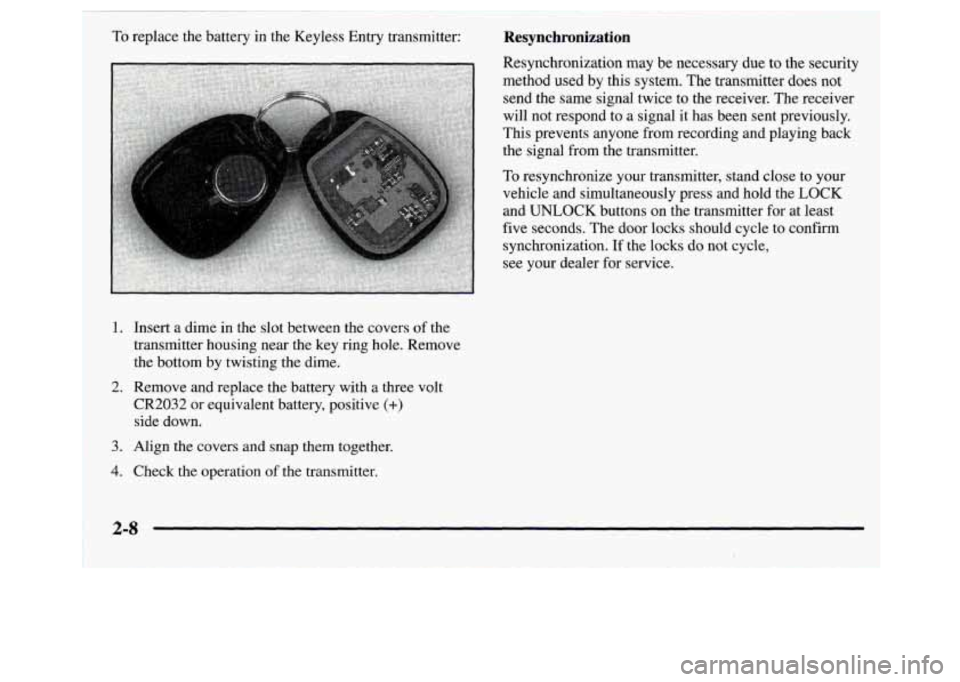
To replace the battery in the Keyless Entry transmitter: Resynchronization
1. Insert a dime in the slot between the covers of the
transmitter housing near the key ring hole. Remove
the bottom by twisting the dime.
CR2032
or equivalent battery, positive (+)
side down.
2.
Remove and replace the battery with
a three volt
3. Align the covers and snap them together.
4. Check the operation of the transmitter. Resynchronization may
be necessary due to the security
method used
by this system. The transmitter does not
send the same signal twice to the receiver. The receiver
will not respond to a signal it has been sent previously.
This prevents anyone from recording and playing back
the signal from the transmitter.
To resynchronize your transmitter, stand close to your
vehicle and simultaneously press
and hold the LOCK
and
UNLOCK buttons on the transmitter for at least
five seconds. The door locks should cycle to confirm
synchronization. If the locks
do not cycle,
see your dealer
for service.
2-8
Page 73 of 410
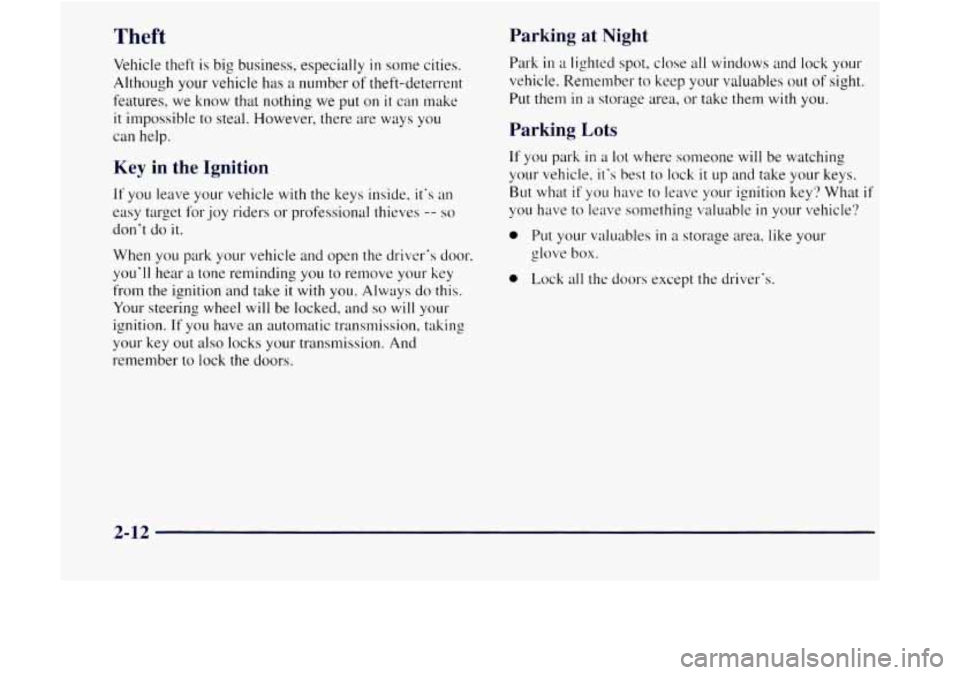
Theft
Vehicle theft is big business, especially in some cities.
Although
your vehicle has a number of theft-deter-rent
features, we know that nothing we put
on it can make
it impossible to steal. However, there are ways you
can help.
Key in the Ignition
If you leave your vehicle with the keys inside, it’s an
easy target for joy riders
or professional thieves -- so
don’t do it.
When you park your vehicle and open the driver’s door.
you’ll hear a tone reminding
you to remove your key
from the ignition and take it with you. Always do this.
Your steering wheel will be locked, and so will your
ignition.
If you have an automatic transmission, taking
your
key out also locks your transmission. And
remember to lock the doors.
Parking at Night
Park in a lighted spot, close all windows and lock your
vehicle. Remember
to keep your valuables out of sight.
Put them
in a storage area, or take them with you.
Parking Lots
If you park in a lot where someone will be watching
your vehicle,
i1.s best to lock it up and take your keys.
But what if ~OLI have to leave your ignition key? What if
you have to leave something \duable in your vehicle?
0 Put your valuables in a storage area, like your
2 Olove box.
0 Lock all thc doors except the driver’s.
2-12
Page 107 of 410

Lamps On Reminder
A reminder tone will sound when your headlamps or
parking lamps are turned
on and your ignition is in OFF,
LOCK or ACCESSORY. To turn the tone off, press the
OFF switch.
Daytime Running Lamps
Daytime Running Lamps (DRL) can make it easier for
others to see the front of your vehicle during the day.
DRL can be helpful in many different driving
conditions, but
they can be especially helpful in the
short periods after dawn and before sunset.
The DRL system will make your headlamps come on at
reduced brightness when:
the ignition is on,
the headlamp switch is off and
the parking brake is released. When
the DRL are
on. only your headlamps will be on.
The taillamps, sidemarker and other lamps won't be on.
The instrument panel won't be
lit up either.
When
it begins to get dark, your DRL indicator light is a
reminder to turn your headlamp switch on. The other
lamps that come on
with your headlamps will also
come on.
When you
turn the headlamp switch off, the regular
lamps will
go off, and your headlamps will change to
the reduced brightness
of DRL.
To idle your vehicle with the DRL off, set the parking
brake. The DRL
will stay off until you release the
parking brake.
As with any vehicle, you should turn on the regular
headlamp system when you need it.
2-46
Page 182 of 410

Traveling to Remote Areas Getting Familiar with Off-Road Driving
It's a good idea to practice in an area that's safe and
close to home before you go into the wilclerness.
Off-road driving does rec1tIir-e some new md cliffrent
driving skills. Here's what we mean.
Tune your senses to different kinds of signals. Your
eyes,
for example, need to constantly sweep the terrain
tor unexpected ohstacles. Your ears need to listen for
unusual tire or engine sounds. With your arms, hands,
feet and body, you'll need to respond to vibrations and
vehicle
bounce.
Whengu're driving off-road, bouncing and
quick changes in direction can
easily throw you
out of position. This could cause you to lose
control and crash.
So, whether you're driving on
or off the road, you and your passengers should
wear
safety belts.
4-17
Page 183 of 410

Scanning the Terrain
Off-road driving can take you over many different kinds
of terrain. You need to be fimilix with the terrain and its
many different features. Here are some things
to consider.
Surfcm Corzc1i~io11.s. Off-roading can take you over
hard-packed dirt, gravel, rocks, grass, sand, rrrud. snow
or ice. Each
of these surfaces affects the steering.
acceleration and braking
of your vehicle in different
ways. Depending upon the kind of surface you are on.
you may experience slipping. sliding, wheel spinning,
delayed acceleration, poor traction and longer
braking distances.
Su@ce Ohstclcles. Unseen or hidden obstacles can be
hazardous. A rock, log, hole, rut or bump can startle you if
you're not prepared for them. Often these obstacles are.
hidden by grass, bushes, snow or even the rise and fall of
the
0
0
0
0
terrain itself. Here are some things to consider:
Is the path ahead clear?
Will the surface texture change abruptly up ahead?
Does
the travel take you uphill or downhill? (There's
more discussion of these subjects later.)
Will
you have to stop suddenly or change
direction quickly? When you
drive over obstacles or rough terrain. keep
a
firm grip on the steering wheel. Ruts. troughs or other
surface features can jerk
the wheel out of your hands if
you're not prepared.
When
you drive over bumps, rocks, or other obstacles,
your wheels can leave the ground. If this happens, even
with one or two wheels. you can't control the vehicle
as
well or at all.
Because you will be on an unpaved surface., it's
especially important to avoid sudden acceleration,
sudden
tl1rnC ot- suclden braking.
In a way. off-road driving requires a different kind of
alertness from driving
on paved roads and highways.
There are
no road signs. posted speed limits or signal
lights.
You have to use your own good judgment about
what is
safe and what isn't.
Drinking
and driving can be very dangerous on any
1-oad. And this is certainly true for off-nmi driving. At
the very tirne you need special alertness and driving
skills, your reflexes. perceptions and judgment can be
affected by
wen a small amount of alcohol. You could
have
:I serious -- or even fital -- accident if you drink
and drivc or ride with a drivel- who has been drinking.
See "Drunken Driving" in the Index.
4-18
Page 205 of 410

Snow can trap exhaust gases under your vehicle.
This can cause deadly
CO (carbon monoxide) gas
to get inside.
CO could overcome you and kill
you. You can’t see it or smell it,
so you might not
know it is in your vehicle. Clear away snow from
around the base of your vehicle, especially any
that is blocking your exhaust pipe. And check
around again from time to time to be sure snow
doesn’t collect there.
Open a window just a little on the side of the
vehicle that’s away from the wind. This will help
keep
CO out.
Run your engine only as long as you must. This saves
fuel. When
you run the engine, make it go a little faster
than just idle. That is, push the accelerator slightly.
This
uses less fuel for the heat that you get and it keeps the
battery charged.
You will need a well-charged battery to
restart the vehicle. and possibly for signaling later on
with your headlamps. Let the heater run for a while.
Then, shut the engine
off and close the window almost
all the way
to preserve the heat. Start the engine again
and repeat this only when you feel really uncomfortable
from the cold.
But do it as little as possible. Preserve the
fuel as long
as you can. To help keep warm, you can get
out of the vehicle and
do some hirly vigorous exercises
every half
hour or so until help comes.
4-40
Page 219 of 410
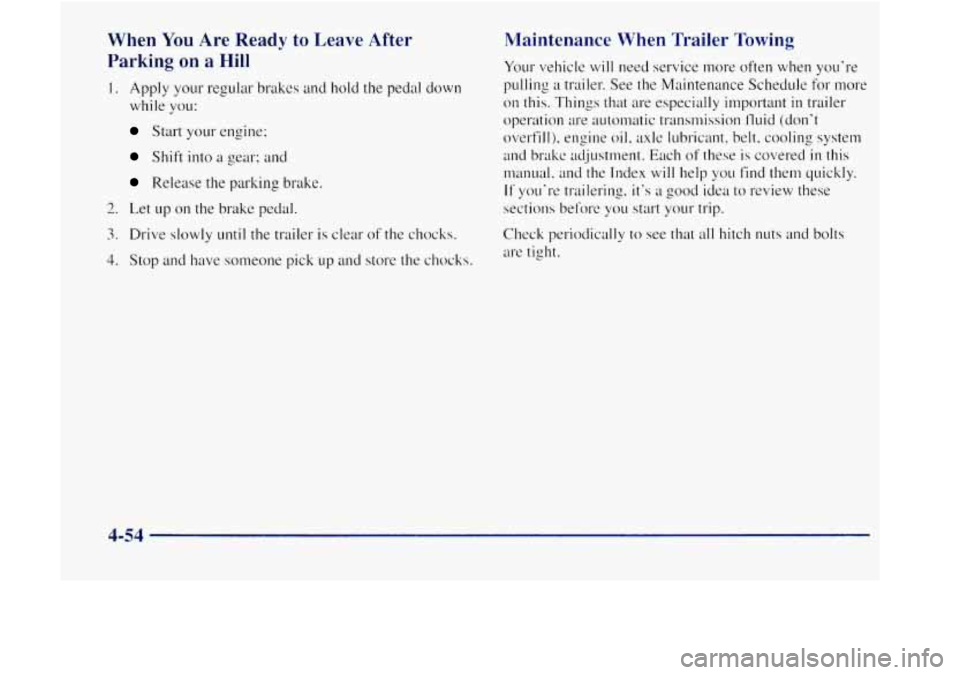
When You Are Ready to Leave After
Parking on
a Hill
I, Apply your reg~~lar brakes and lwld the pedal down
while you:
Start your engine;
Shift into a gear: and
Release the parking brake.
2. Let up on the brake pedal.
3. Drive slowly until the trailer is clear of the chocks.
4. Stop and have someone pick up and store the chocks.
Maintenance When Trailer Towing
Your vehicle will need service nlore often when you're
pulling a trailer. See the Maintenance Schedule for more
on
this. Things that are especially important in trailer
operation
are automatic transmission fluid (don't
overfill), engine
oil. ~~xle lubricant, belt, cooling system
and
brakc adjustment. Each of these is covered in this
manurd.
and the Index will help you find then] quickly.
If you're trailering. it's a good idea to review these
sections before you start your trip.
Check periodically
to see that all hitch nuts and bolts
are tight.
4-54